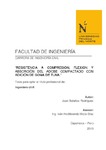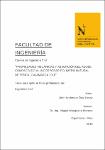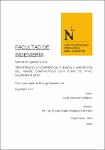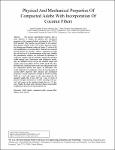Mostrar el registro sencillo del ítem
Resistencia a compresión, flexión y absorción del adobe compactado con adición de goma de tuna
| dc.contributor.advisor | Mejía Díaz, Iván Hedilbrando | |
| dc.contributor.author | Bolaños Rodríguez, Juan | |
| dc.date.accessioned | 2017-06-19T14:17:41Z | |
| dc.date.available | 2017-06-19T14:17:41Z | |
| dc.date.issued | 2016-05-19 | |
| dc.identifier.citation | Bolaños, J. (2016). Resistencia a compresión, flexión y absorción del adobe compactado con adición de goma de tuna (Tesis de licenciatura). Repositorio de la Universidad Privada del Norte. Recuperado de https://hdl.handle.net/11537/10482 | es_PE |
| dc.identifier.other | 624 BOLA 2016 | es_PE |
| dc.identifier.uri | https://hdl.handle.net/11537/10482 | |
| dc.description.abstract | RESUMEN La presente tesis tuvo como objetivo evaluar la resistencia a compresión, flexión y absorción del adobe compactado con adición de goma de tuna, para ello se realizó el estudio de suelos para caracterizar los materiales y elaborar bloques de adobe compactado. La tierra utilizada para la elaboración de las unidades fue extraída de la cantera “Shaullo Chico”, inicialmente se realizó el análisis granulométrico y los límites de consistencia para clasificar los suelos y ver si cumple con los requisitos que exige la N.T.P E.080, luego a través del ensayo de Proctor Modificado permitió determinar la cantidad de agua necesaria utilizada en los bloques de tierra de la muestra patrón elaborados sin goma de tuna y en los bloques de tierra con porcentajes de 5%, 10% y 15% con goma de tuna, estos adobes fueron elaborados a través de la máquina CINVA RAM, disponible en la Universidad Privada del Norte Cajamarca. Los resultados obtenidos del ensayo a compresión, en mitades, nos indican que todos los adobes superan la resistencia mínima que indica la norma técnica de edificaciones E.080, los resultados de la muestra patrón y con goma de tuna de 5%, 10% y 15% presentan valores de 19.19 kg/cm², 21.90 kg/cm², 25.27 kg/cm² y 27.56 kg/cm² respectivamente, siendo el adobe con mejor resistencia a la compresión el de 15% con goma de tuna. Para el ensayo a flexión y absorción la norma técnica de edificaciones E.080, no especifica parámetros, para ello se realizó teniendo en cuenta la norma ASTM-C67, donde se obtuvieron resultados para la muestra patrón de 4.77 kg/cm² y para los porcentajes de 5%, 10% y 15% presentaron valores de 6.47kg/cm², 6.81 kg/cm² y 6.11 kg/cm² respectivamente, siendo el adobe con mejor resistencia a la flexión el de 10% con goma de tuna. El ensayo de absorción de las muestras patrón y la muestra de15% de goma de tuna no se no resistieron la prueba, en cambio con los porcentajes de 5% y 10% se obtuvo una absorción de 12.68% y 14.62%. | es_PE |
| dc.description.abstract | ABSTRACT This thesis aimed to evaluate the compressive strength, bending and absorption of compacted rubber addition tuna, for which the soil study was performed to characterize and develop materials compacted adobe adobe blocks. The land used for the production of the units was quarried "Shaullo Chico", initially the particle size analysis and consistency limits was made to classify soils and see if it meets the requirements under the NTP E.080, then through trial Modified Proctor allowed to determine the necessary amount of water used in blocks of land pattern made without rubber tuna sample and earth blocks with percentages of 5%, 10% and 15% gum tuna these bricks were made through the CINVA RAM, available at the Private University of North Cajamarca machine. The results of the compression test, halved, indicate that all adobes exceed the minimum resistance indicating the technical standard E.080 buildings, the results of the standard sample and tuna paste of 5%, 10% and 15% have values of 19.19 kg / cm², 21.90 kg / cm², 25.27 kg / cm² and 27.56 kg / cm² respectively, the adobe compressive strength better than 15% with rubber tuna. For testing bending and absorption of the technical standard E.080 buildings, it does not specify parameters for it was made taking into account the standard ASTM-C67, where results for the standard of 4.77 kg / cm² sample was obtained and the percentages of 5%, 10% and 15% had values of 6.47kg / cm², 6.81 kg / cm² and 6.11 kg / cm² respectively, adobe with better flexural strength of 10% with the rubber tuna. The absorption test standard samples and the sample of15% rubber tuna not not withstood the test, whereas the percentages of 5% and 10% absorption of 12.68% and 14.62% was obtained. | es_PE |
| dc.description.uri | Tesis | es_PE |
| dc.format | application/pdf | es_PE |
| dc.format | application/msword | es_PE |
| dc.language.iso | spa | es_PE |
| dc.publisher | Universidad Privada del Norte | es_PE |
| dc.rights | info:eu-repo/semantics/openAccess | es_PE |
| dc.rights | Atribución-NoComercial-CompartirIgual 3.0 Estados Unidos de América | es_PE |
| dc.rights.uri | https://creativecommons.org/licenses/by-nc-sa/3.0/us/ | * |
| dc.source | Universidad Privada del Norte | es_PE |
| dc.source | Repositorio Institucional - UPN | es_PE |
| dc.subject | Resistencia a la compresión | es_PE |
| dc.subject | Suelos | es_PE |
| dc.subject | Materiales | es_PE |
| dc.title | Resistencia a compresión, flexión y absorción del adobe compactado con adición de goma de tuna | es_PE |
| dc.type | info:eu-repo/semantics/bachelorThesis | es_PE |
| thesis.degree.grantor | Universidad Privada del Norte. Facultad de Ingeniería | es_PE |
| thesis.degree.level | Título Profesional | es_PE |
| thesis.degree.discipline | Ingeniería Civil | es_PE |
| thesis.degree.name | Ingeniero Civil | es_PE |
| dc.publisher.country | PE | es_PE |
| dc.subject.ocde | https://purl.org/pe-repo/ocde/ford#2.01.01 | es_PE |
| thesis.degree.program | Pregrado | es_PE |
| dc.description.sede | Cajamarca | es_PE |
| renati.advisor.dni | 46448663 | |
| renati.author.dni | 43765182 | |
| renati.discipline | 732016 | es_PE |
| renati.juror | Aguilar Aliaga, Orlando | |
| renati.juror | Alva Sarmiento, Anita | |
| renati.juror | Chávez Toledo, Teresa | |
| renati.level | https://purl.org/pe-repo/renati/level#tituloProfesional | es_PE |
| renati.type | https://purl.org/pe-repo/renati/type#tesis | es_PE |
Ficheros en el ítem
Este ítem aparece en la(s) siguiente(s) colección(ones)
-
Tesis [1437]








